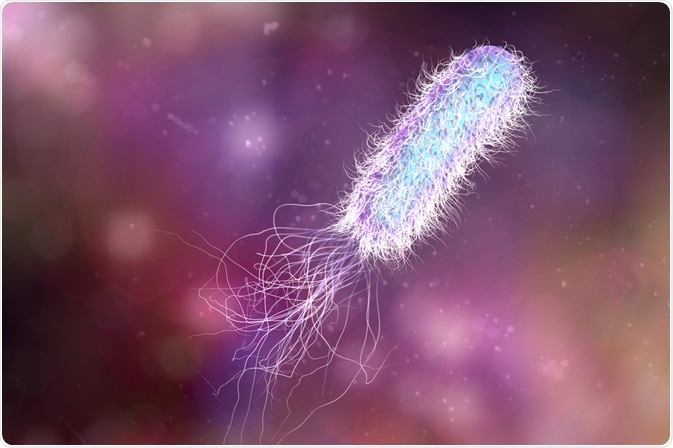Flagella are composed of over 20 unique proteins and represent a complex set of molecular machinery, working in unison to provide motility to many Gram-negative and positive species of bacteria, as well as some Archaea and eukaryotic cells.
 Image Credit: Kateryna Kon/Shutterstock.com
Image Credit: Kateryna Kon/Shutterstock.com
Bacteria may bear one or several flagella, which may be located on one spot to provide forward movement (polar) or spread over the surface to allow tumbling in place. Besides motility, flagella can participate in protein export, cellular adhesion, and biofilm formation, strongly influencing the virulence of a pathogen.
Bacterial adhesion is an essential step in colonization, and bacteria present a variety of adhesion structures, largely surface proteins, which are not typically presented at the same time as flagellum. This allows bacteria to switch between motile and sessile forms, usually triggered by environmental conditions such as nutrient or toxin concentration, pH, temperature, etc. However, flagella can also provide adhesion to particular biomolecules, promoting the probability of a bacteria ceasing motility and beginning colonization in a favorable location.
Experiments on the function of flagella
Primarily, flagella promote virulence by facilitating motility, and many bacteria are highly virulent thanks to their high motility.
Vibrio cholerae has a single polar flagellum, and studies in mice demonstrate that non-motile Vibrio cholerae with a disabled flagellum are notably decreased in virulence, with a significantly lowered adsorption through the intestine.
Salmonella enterica (Enteritidis) bears several flagella arranged around the cell (peritrichously), and studies show that functional flagella enhance the virulence of the bacteria, though there is little difference in adhesion and invasion ability when comparing mutants bearing non-functional flagella and those with no flagella at all. This suggests that flagella themselves are not necessary for adhesion in this species - this function is provided by surface proteins or other structures.
However, non-flagellated mutants also appear to interact with host cell membranes in a different manner than wildtype in some studies, indicating that flagella are involved in an as-yet uncharacterized invasion process. Interestingly, S. Typhimurium bearing deactivated but present flagella has demonstrated increased virulence when delivered directly into the abdominal cavity (intraperitoneally), indicating that they are not required for motility but do provide adhesion functionality once at the systemic stage of infection.
Many other bacterial species rely on flagella more heavily to facilitate adhesion, common examples of such pathogens including E. coli and Pseudomonas aeruginosa. There are many sub-types of E. coli, which utilize their flagella for adhesion to differing extents. Flagellum sourced from enteropathogenic E. coli demonstrate co-elution following incubation with bovine and porcine mucins, and non-flagellated mutants adhere to intestinal tissue significantly less strongly than wild-type. Purified flagella from this strain also interact with extracellular matrix proteins collagen and laminin, while flagella purified from strains of the H7 serotype do not. This may promote colonization at sites where the intestinal barrier is disrupted in the former (H6). In some strains, H7 flagella are only present at the early stages of colonization, and their formation is repressed in microcolonies, suggesting that they are not needed at later stages of infection. The variety of adhesion interactions that the numerous types of flagella may have with host biomolecules strongly influences the usual site of colonization during infection, with E. coli pathovars targeting the small intestines, large intestines, brain, blood, ileum of small bowel, vasculature, or other specific locations depending on these interactions.
Targets of flagellum adhesion
Pseudomonas aeruginosa also binds with mucin to aid with adhesion to the lung epithelium, demonstrated by defective adhesion in non-flagellated mutants. However, the specific protein of the flagellum that mediates adhesion is not yet clear.
Removal of the flagellar cap protein appears to inhibit adhesion the most strongly, though this is highly dependent on the specific strain and culture conditions. Another biomolecule that has been shown to adhere to flagella in various studies includes heparan sulfate proteoglycans at the basolateral surface of polarized Calu-3 cells, inducing the PI3K/Akt pathway and allowing bacterial entry into the epithelial cells.
Gangliosides have been reported in a number of studies as binding targets for flagella, also being involved in flagellin-mediated signaling in eukaryotic cells. Flagellin is the major constituent protein of the flagella and has been shown to bind with glycolipid receptors on some cells.
In Chinese hamster ovary cells with inserted glycolipid receptors, flagellin produced a significant inflammatory response, stimulating the production of mucin and thereby promoting biofilm formation in some bacteria species, such as Pseudomonas aeruginosa.
Only a relatively small set of flagellar adhesion receptors have been discovered so far, often being highly specific to the species and strain of bacteria, and the host. Similarly, flagella are heavily involved in the generation of an immune response, with many antibodies against particular regions of the flagella being produced upon pathogenic infection.
Constituents of the flagellum of various species of bacteria have therefore been included in vaccines as an adjuvant, and drugs aimed at disrupting the vital function of the flagellum in pathogenic bacteria are also in development.
References:
Further Reading
Last Updated: Oct 4, 2021